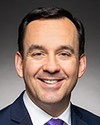I'll just canvass quickly: Do we have unanimous consent to pass the motion?
It looks like we do.
(Motion agreed to)
Evidence of meeting #50 for Veterans Affairs in the 44th Parliament, 1st Session. (The original version is on Parliament’s site, as are the minutes.) The winning word was research.
A video is available from Parliament.
7:15 p.m.
Conservative

The Vice-Chair Conservative Blake Richards
I'll just canvass quickly: Do we have unanimous consent to pass the motion?
It looks like we do.
(Motion agreed to)
7:15 p.m.
The Chair
Thank you, Mr. Desilets.
7:15 p.m.
Conservative

The Vice-Chair Conservative Blake Richards
You still have about five and a half minutes for your questions.
7:15 p.m.
Bloc

Luc Desilets Bloc Rivière-des-Mille-Îles, QC
My apologies for that brief interruption.
My first question is for Ms. Courchesne.
Ms. Courchesne, does VAC collect data on the number of claims received in relation to military sexual trauma experienced by women?
7:15 p.m.
Chief Medical Officer, Department of Veterans Affairs
Thank you for your question.
My division doesn't receive the claims. My colleague Trudie MacKinnon's does, so, once again, I'm going to have to pass the question over to her. She will have more information on that.
7:15 p.m.
Acting Director General, Centralized Operations Division, Department of Veterans Affairs
In regard to military sexual trauma, we were responsible for processing all the claims in the Heyder Beattie class action suit. I have some statistics in regard to that. Of all the claims that came forward, 72% were from females. Although the claims period is closed for those claims, we continue to work with the parties in order to finalize them.
I will also say in regard to military sexual trauma that we have a unit dedicated to dealing with those claims, and they have developed an expertise over the course of the past several months in dealing with those claims. Our intention is to maintain that unit going forward, so that as those claims come in, we have staff who are trained and have a competency and a sensitivity in dealing with those types of disability applications.
That is our plan moving forward. We anticipate that we will continue to receive those, outside of any type of class action, and will continue to support members as they come forward with those types of issues.
7:20 p.m.
Bloc

Luc Desilets Bloc Rivière-des-Mille-Îles, QC
Thank you, Ms. MacKinnon.
Would you be able to forward the data you have now to the committee, specifically, the number of claims and anything else that might be relevant?
7:20 p.m.
Acting Director General, Centralized Operations Division, Department of Veterans Affairs
Is that for females in general, or just for military sexual trauma?
7:20 p.m.
Bloc

Luc Desilets Bloc Rivière-des-Mille-Îles, QC
It would be good to have the data on military trauma in general, but right now, the committee is focusing on women.
May 4th, 2023 / 7:20 p.m.
Acting Director General, Centralized Operations Division, Department of Veterans Affairs
In the past fiscal year, 2022-23, we received just under 1,400 claims for military sexual trauma. Some of those would have been in relation to the Heyder Beattie class action. Others would not have been. They would have been just people coming forward on their own.
The year prior to that, it was just over 1,500. In 2020, we received 500.
7:20 p.m.
Bloc

Luc Desilets Bloc Rivière-des-Mille-Îles, QC
Again, I'd like you to provide those helpful data to the committee, if you could.
Dr. Courchesne, since we began this study on women veterans, we've heard a lot about data—the fact that they aren't always shared and that a lot of organizations collect the data.
Would you say all the organizations concerned share the information or data sufficiently?
7:20 p.m.
Chief Medical Officer, Department of Veterans Affairs
Thank you for your question.
Our colleagues in research and the people at research institutes work in partnership. The information flows back and forth.
I think there's a high level of co‑operation. That's why the centre of excellence was set up. The idea was to foster connections within the community in order to access as much information as possible. My fellow witnesses Ms. MacLean or the Atlas Institute representatives may have views to share. From my standpoint, the level of co‑operation is quite good. Internationally, even, we have information sharing and a lot of co‑operation, specifically with our Five Eyes partners.
7:20 p.m.
Conservative

The Vice-Chair Conservative Blake Richards
Thank you.
To our witness, our analyst has put a bug in my ear, and we'd like to get a sense.... Of the 3,500 claims you mentioned, how many were accepted and how many were denied? Do you have that information?
7:20 p.m.
Acting Director General, Centralized Operations Division, Department of Veterans Affairs
I don't, unfortunately, right now, Mr. Chair, but I'm happy to come back with that.
7:20 p.m.
Conservative

The Vice-Chair Conservative Blake Richards
If you could send that information to our clerk, it would be appreciated. I think that would help our analyst with the report we will write when we conclude the study.
Thank you very much for that. We'll expect that information from you.
We now have the New Democratic Party for the next six minutes, for the final portion of the first round.
We'll go to Ms. Blaney.
7:20 p.m.
NDP

Rachel Blaney NDP North Island—Powell River, BC
Thank you so much, Chair, and thank you to all of our witnesses for being here.
To those of you who served our country, I deeply appreciate the service that you provided then and provide today.
I'm going to start with Atlas first. You decide who should answer the question, but I will be asking everyone. If you can listen to the question and decide who is the best to answer, I would really appreciate it.
What we've heard repeatedly in this study from women veterans is that they feel invisible and that data isn't collected, so they don't know the trends of what's happening. They find that a lot of their health care challenges are not recognized and their employment challenges are not recognized. There doesn't seem to be a clear pattern.
We also know that it's a low number we're looking at.
How do we address the issue, specifically about research, when we have such a small dataset? How do we make sure that in that reality, we don't make invisible the real issues that women veterans are facing?
7:25 p.m.
Director, Applied Research, Atlas Institute for Veterans and Families
This notion of invisibility is something that we've also heard about anecdotally in conversations we've had with women veterans and with partners in other organizations. This committee has also heard about their not feeling like a veteran or not identifying as a veteran, or a reluctance to do so.
In terms of the data that is collected, perhaps it's important to clarify that the challenge we see is with the quality of some of the data that is available. The committee has heard about small sample sizes. This is also something that we are aware of. In many cases, the small sample sizes or low cell counts make it quite difficult to provide findings that are reliable, meaningful and interpretable and that can help us draw conclusions to provide reasonable recommendations or salient conclusions on a particular issue.
Perhaps there's an important question to be asked, not about what data we collect but about what questions we ask. Many of the studies where data is currently available to us, such as the life after service survey, are designed for performance measurement and for surveillance. They are population-based studies that, as you've heard in prior witness statements, give us the ability to compare across the population or compare female veterans to male veterans, but perhaps we need questions about women veterans in their own right—questions that take gender as a category of analysis, that look at the sex- and gender-specific needs of women veterans, that focus exclusively on their experiences, and that are relevant to them.
I hope that's helpful.
7:25 p.m.
Consulting Research Associate, As an Individual
I agree with Dr. Rodrigues. When you're doing population health research, you're getting a random sample of veterans, so you're going to get 13% females. A lot of the indicators of well-being—at Veterans Affairs, 21 indicators are used—are not gendered indicators. Across the seven domains of well-being, all of those should be disaggregated by sex. That's the ideal way to analyze the data. However, as she mentioned, they're small sample sizes, so the confidence intervals are wide. It's hard to tell if there is in fact a difference between women and men.
As Dr. Courchesne mentioned, there is some hope there in terms of getting larger sample sizes of veterans with the 2021 census data. There have been releases of some of that data already, but there haven't been enough releases yet to look specifically at women. Yes, data does need to be disaggregated.
7:25 p.m.
Chief Medical Officer, Department of Veterans Affairs
Thank you.
I want to preface by saying that I'm not a researcher. We rely heavily on our research colleagues to provide information. I find that they provide a lot of excellent information. We learn so much about the experience of veterans around transition especially, but there are some gaps.
It's an excellent question about the women feeling invisible. That's why another step we're taking is to do this community health needs assessment. It will go and look for those who are under-represented, and women specifically, to ask them about what needs are not being met and all that. We use all the information to build a picture. It's sort of like a puzzle. Everybody has part of the information, but we want to put it all together to paint a clear picture, especially for under-represented veterans and women.
Thank you.
7:30 p.m.
Conservative

The Vice-Chair Conservative Blake Richards
We've arrived at the end of the round, Ms. Blaney.
We'll move now to our second round. We will have two different sets of questions from the Conservative and Liberal parties for five minutes each, sandwiched around two-and-a-half-minute rounds for the Bloc Québécois and the NDP.
We will start the second round with five minutes for the Conservative Party.
Mrs. Cathay Wagantall, please go ahead.
7:30 p.m.
Conservative

Cathay Wagantall Conservative Yorkton—Melville, SK
Thank you very much, Chair.
Thank you all for being here. For those of you who have served, I deeply appreciate your commitment to Canada in whatever role you're playing.
First of all, I would like to ask Dr. Courchesne some questions in regard to conversations we've had here with the CAF on this new move to the military-to-civilian transition process. It's apparently in place now. We've been waiting for the seamless transition program for some time.
Specifically for those who are medically releasing, it moves from a transition adviser to a release administrator. Then the individual who is transitioning moves to a VAC service agent, if—as was commented—that's required.
Can you tell me whose responsibility it is to determine if they need a VAC agent? Is it your experience that veterans transition and then over time start to realize what some of their conditions are?
Do you feel that this is something they should have in place as they make that seamless transition, yes or no?